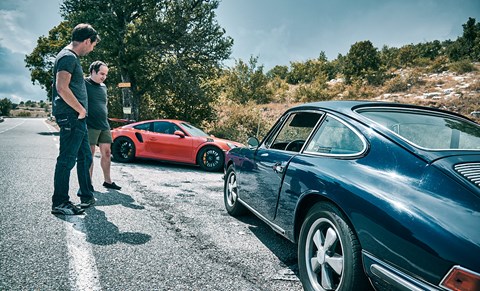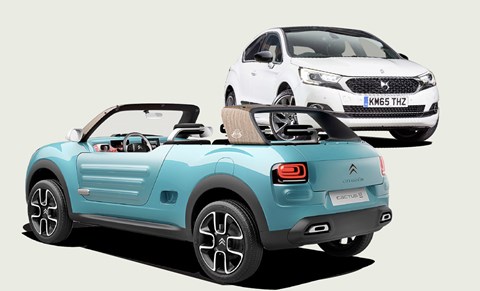► CAR Interactive: your say on our stories
► Each month we search for the best comments
► The best reader feedback from myriad sources
Robot wars in Sunderland: via email
I enjoyed the tour you gave us of Nissan’s Sunderland factory (CAR, February). Amazing images. What struck me was the extraordinary complexity of the robots involved in producing what I think of as relatively hum-drum cars. The cars may be hum-drum but the robots aren’t. With two cars rolling off the line every minute I hope the robots are more precise than my first-gen Qashqai was!
John Birtwhistle
On four-pot Porsches: via Facebook
It’s a lot of money for a four-cylinder sports car, even if it performs better than the six before it. Looks fantastic however.
Brett Nicolls
Porsche finally becomes a badge within VW.
Ian Miles
Via car online
As long as Porsche can get the sound right, I have no problem with four-pots. Sure, I bought my current Cayman partly for its six-pot, which sounds sublime, but Porsche knows that if these engines don’t sound really good they’re going to have problems. The additional low/mid torque will be welcomed over the normally aspirated sixes, not to mention huge savings at the pumps! Even the 911 will go this way fairly soon.
Nozydog
The savings made by Porsche’s downsizing are negligible: one litre every 100km, which in an average Porsche life equates to about £2500. Not even sufficient to pay for the navigation system. You can laugh.
Cavaliere Blu
Notes from an M4 owner: via email
I think Ben Barry (CAR, February) was unduly harsh on the BMW M4. I bought an M4 in March 2015 and I’ve done some 14,000 miles in it including one trip to Germany and one to Poland. In Germany the car cruises with ease at 130mph and will do 160mph. Fuel consumption for the life of the car is 28mpg and I cannot imagine either the Mustang or the Lexus RCF achieving anywhere near these figures.
It is an unassuming wolf in sheep’s clothing but with great performance and build quality and without the bling chav factor of the other two cars tested. I have driven in truly vile conditions and the car appears impervious to torrential rain and strong winds including one nine-hour spell trying to claw my way north up the M6. It sounds great too, despite Ben Barry’s comments – perhaps a few miles have cleaned out the exhaust rather than three days’ driving in Kielder Forest! I believe my comments on this car after nearly a year of ownership and real varied driving are more relevant.
Charles Bennie

On Defender R.I.P.: via Facebook
You can’t reinvent the wheel. They should have continued with this model unless the sales weren’t there. Any issues with emissions can be addressed with software. Switch from analogue to digital and keep this vehicle in production.
Robert Williams
Thirty years past its sell-by date. Kept alive by misty-eyed nostalgia and sheer bloody-mindedness. We’ve had decades of other vehicles being able to do better ‘Defender-ing’ than the Defender, stronger and more reliable, all without boasting 1950s levels of technology and build quality.
Martin Pretorious
Changing this model will be one of the biggest mistakes. I believe that some iconic things cannot change, especially when you have models that could satisfy the rest of your customers’ needs. All major brands have such examples, from cars (Mercedes with the G-Wagen), to bags (Luis Vuitton’s traditional coloured-shaped bag) even to soft drinks (Coke). A legendary product such as the Defender can get more modern but without touching its exterior body shape.
Alexander Michalas
The decision to end the Defender is not just about emissions or safety, it’s about the failure to invest further in it, as Mercedes has in the G-class. I would like to see an aluminium separate chassis on the next model.
Nigel Hughes
Welcome back, Bayley: via email
Good to see Stephen Bayley back in Car analysing the Lexus NX. As a design critic he’s incomparable! More from him please!
Geoff Purkis

Caution: wide 911: via email
That classic 911 pictured alongside the GT3 RS on a Monte roadside (CAR, February) illustrates just how wide modern 911s have now become. Ben Barry conceded this himself, saying the RS felt ‘…a size too large for these undersized roads’. Further proof, post-Cayman GT4, that a motorsport-developed 911R – hopefully based on the standard Carrera bodyshell – can’t come soon enough. Roads aren’t getting any wider, Porsche, and neither should your cars.
Mike Spencer
Peerless Morgan: via email
The piece on the Porsche 911 GT3 RS was terrific and I love 911s in general. However, your picture on pages 88/89 shows one guy looking at the GT3 (taking a photo), while nearly everyone else is looking at the car in front of the steps, a Morgan Aero. Makes you think!
Jeff Simpson
Lesser spotted Falcon: via email
It’s great that you guys head down here to Australia to test some Euro machinery in the Outback. Your numerous tests of the VXR8 (which is of course just an HSV with a badge) are also appreciated. But if you’re going to come all this way, why not take a look at the other Australian performance product that Ford keeps a secret from the rest of the world – the Falcon XR8.
Yes, it is in its final version before being discontinued, but where else in the world does Ford make a supercharged V8 sedan that puts out 450bhp and 420lb ft with proper independent rear end? Or better yet, the just discontinued FPV ute with the same drivetrain. After it’s gone we will probably never see its like from Ford ever again. I still can’t figure out why Ford never exported them – would have sold like hot cakes.
Martin Vassallo
Gavin hits nail on head: via email
I’ve just read Gavin Green’s column (CAR, January). One of the best columns I’ve read for a long, long time – both informative and thought-provoking. Thinking about rotary engines, or turbines, being used to generate electricity to drive the vehicle makes a lot of sense. More efficient, less polluting, using less fuel – it all adds up. The oil producers will get a stay of execution as consumption of petroleum products will drop dramatically, although there will still be a need for them until an alternative can be found (hydrogen, perhaps). The only downside is that the lovely soundtracks of Porsche, Ferrari etc will disappear. Small price to pay?
Terry Clear
Wheel reinvention: via email
Many thanks to Mark Walton for his column on the correct way to grasp a steering wheel, ie at quarter-to-three (CAR, January). I’m now driving like Stig Blomqvist in my Audi A3 Quattro. A new problem with wheel design has however manifested itself: with each turn the radio changes stations unbidden due to the poorly placed tuning control directly under my left thumb. I patiently await phase 2 of your fix-the-wheel campaign. My solution in the meantime? I’ve changed every preset to the same station! Thanks for another great piece.
Thomas Novicki
Wheels within wheels: via email
Apart from ‘a quarter-to-three’ being a great line in a song, Mark Walton’s piece on steering wheels really amused me – especially his comments on the two-minutes-to-twelve position (we all know one!). Quarter-to-three (2.45) feels just right, especially if your steer requires only two turns lock-to-lock, but he’s dead right about the ten-to-two thing, so I thought I’d do a bit of quick research using the January issue, and here’s what I found.
Safety stalwarts Volvo are clearly advocating ten-to-two (see p14), as do all the other MPV products on pages 44/ 45. Interestingly, your own Ben Oliver is piloting a Bentley at speeds of 200mph on page 116, but still feels comfortable at ten-to-two. Not so messers Chris Chilton at the wheel of the F12tdf or Greg Fountain at the wheel of the Golf Clubsport; indeed, the latter seems to have rejected any VW-suggested hand positions in favour of the recommended 2.45.
And then we have the Vauxhall driver on page 28, who seems not to be worried about catching himself in a painful spot… or perhaps he’s taking care to avoid all those annoying, increasingly distracting buttons that car makers now place at 2.45, exactly where your palms are supposed to rest. Duuhhh!
Roger Adshead
F-Pace on rubbish rims: via email
Yours were by far the best pictures of the Jaguar F-Pace (CAR, February). But the wheels are humungous – how pathetic will it look on weedy 18s?
Euan McCready

DS: 30 years of hurt (letter of the month)
There were at least three references in your February issue to the statement by Carlos Tavares, the boss of Peugeot Citroën, that it will take 30 years for DS to be a successful premium brand. He seems to base this assertion on the fact that it took Audi about that long to achieve the same. That’s an absolutely incredible thing for a company boss to say. Imagine going to your shareholders with any plan and telling them it’ll take a generation to pay off! The exit’s over there. More incredible, however, is the idea that Citroën could – or should – become a premium brand. It seems to me that the fact you can make more money out of premium is not just a reflection of the type of product but a reflection of how the company is run. If Citroën stuck to clever, simple, cheap, funky ideas (like Cactus!) and built them efficiently, it could succeed, own a market segment, and not take 30 years doing it.
Jack Coleman
Read more from the March 2016 issue of CAR magazine